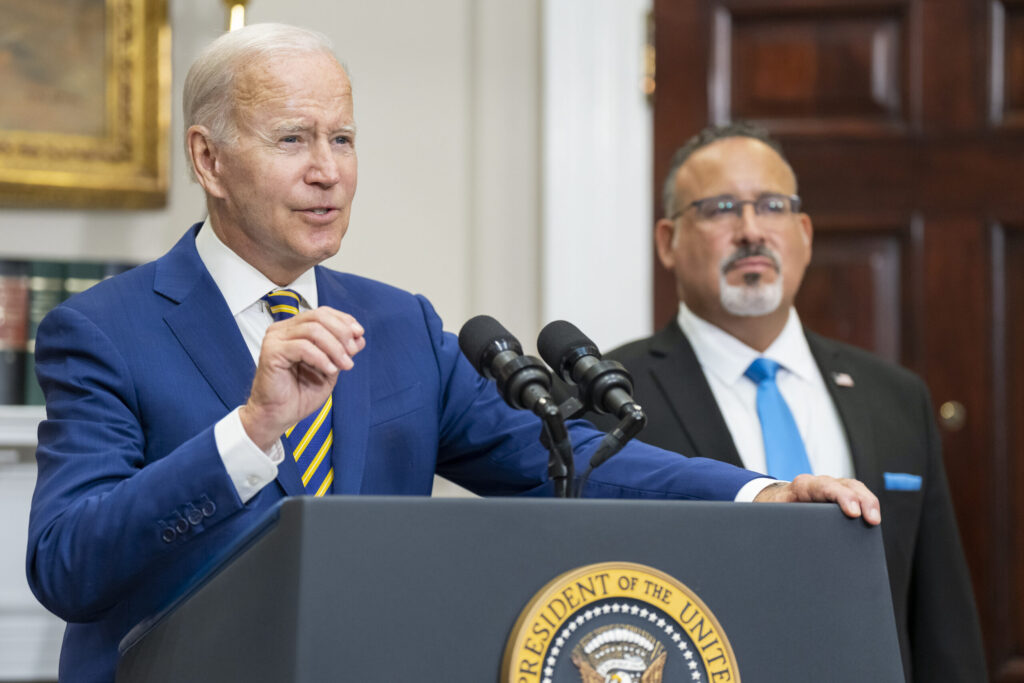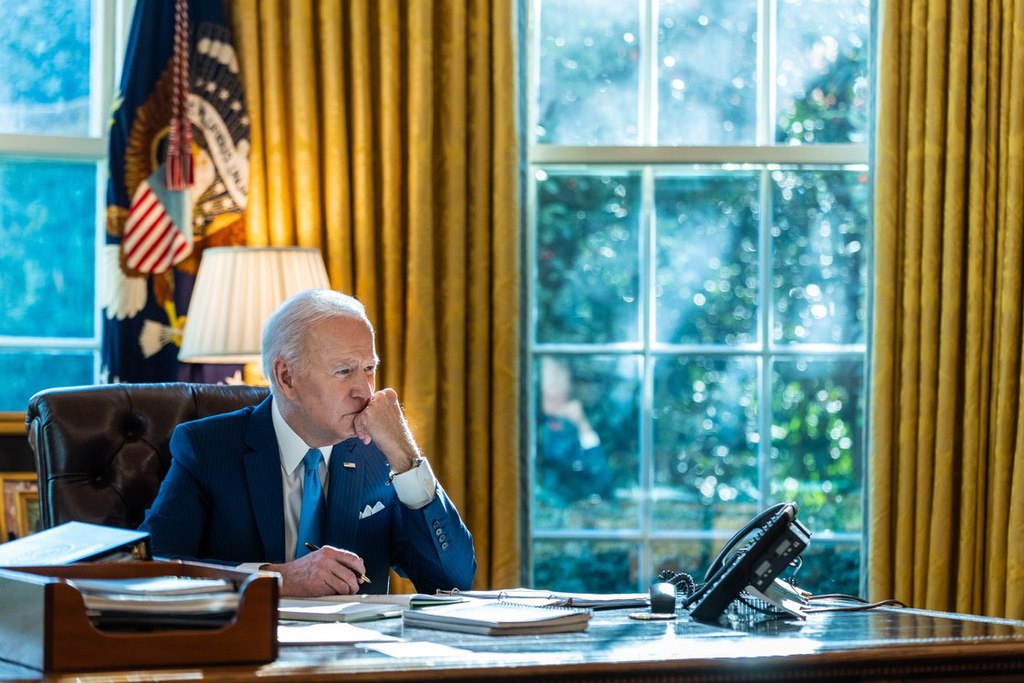
Three years in, what can Biden still accomplish for transportation?

In November 2020, we sent the incoming Biden administration a memo outlining executive actions and long-term legislation we urged the new president to initiate. After three full years in office, modest progress has been made—but there’s still a long way to go.
There are less than 365 days remaining until another administration is inaugurated, whether it be a second-term for Biden or the inauguration of a new successor. We’ve recapped the administration’s progress after their first year and their second year, and modest progress has been made. Entering this final stretch, the administration needs to shift towards bold and decisive action.
The good: Delivering critical standards for accountability
Long overdue GHG measure finalized
On November 22nd, 2023, the US Department of Transportation (DOT) re-established the Greenhouse Gas (GHG) Emissions Measure, which requires state DOTs and metropolitan organizations (MPOs) to measure and report their transportation-associated emissions, as well as set declining targets to reduce their emissions.
The rule does not provide any incentives for state DOTs and MPOs to set aggressive goals for emissions reduction, nor does it impose any penalties for failure to meet targets. However, with the transportation sector being the largest contributor to emissions in the US, this rule is an important first step towards accountability of the federal transportation program. Despite some opposition to this new rule, states can start setting targets and make progress towards their goals immediately. Though stronger incentives and enforcement mechanisms could strengthen implementation of the rule (and this would be a great role for Congress to step in on, akin to the recently introduced Green Streets Act (SB 3669)), it is an important first step towards meaningful action in centering transparency and accountability in our transportation system.
Much-awaited MUTCD update
The Federal Highway Administration (FHWA) released the 11th edition of the Manual on Uniform Traffic Control Devices (MUTCD), which is used by transportation agencies to design safe and efficient streets for users. The MUTCD contains long-awaited updates on moving closer towards a transportation system that is safe, equitable, and sustainable.
Although the MUTCD contains necessary improvements, such as allowing speed limits to be set based on local safety needs, there are still areas where reform is required to ensure safer streets for all. The FHWA has voiced interest in the MUTCD to be a living document that is flexible to the ongoing input of stakeholders. This feedback loop and process of transparent communication will help ensure that it is meeting the moment of a goal of zero roadway fatalities.
Adoption of PROWAG
The U.S. Access Board adopted the Public Right-of-Way Accessibility Guide (PROWAG), which looks to make equitable access to pedestrian facilities in urban areas a reality by providing enforceable accessible design requirements. Guidelines such as accessible pedestrian signals and wheelchair-accessible transit stops are fundamental components of safe and accessible streetscapes. PROWAG represents a significant step in advancing the rights and mobility of persons with disabilities, filling a regulatory gap in the implementation of the Americans with Disabilities Act of 1990. The only thing left to do now is ensure that it is actually fully enforced and adopted by the Department of Justice and Department of Transportation.
The incomplete: Challenging the status quo
Prioritizing resources for vulnerable communities
The administration is committing money and action towards efforts like Justice40, which looks to invest at least 40% of federal climate and infrastructure investments towards marginalized and overburdened communities. This initiative presents an opportunity to rectify gaps in transportation infrastructure created through decades of disinvestment in communities, but there is still more work to be done. Meaningfully creating projects that benefit those who need them most means embedding equity in every step of the process—be it public engagement or implementation. There needs to be transparency in oversight and in tracking how the money is being used. As of now, it is unclear whether funding is allocated on the basis of where environmental justice communities are located or who will enjoy the benefits of these investments.
(Still) unrepresentative Amtrak Board
For the first time in 8 years, the U.S. Senate confirmed three nominations for Amtrak board members. There are unprecedented levels of funding available for the expansion of passenger rail services, but without sufficient representative oversight, this funding can’t advance efficient Amtrak operations. Amtrak was not created solely for the Northeast Corridor, it was created to support long-distance passenger rail in the national network. Representation is required from the many diverse regions that Amtrak serves, such as rural America. However, with two out of the three nominations hailing from the Northeast Corridor, current nominations still fail to reflect all of the U.S.
Lots of talk on safety, little action
It is no secret that the dangerous design of our roadways contributes to rising pedestrian and cyclist fatalities, with the size of cars and SUVs playing a big role in jeopardizing the safety of road users. The National Highway Traffic Safety Administration (NHTSA) is revising vehicle safety design and standards to consider the safety of people on the streets, not just those inside vehicles. It is crucial that these safety standards directly tackle vehicle size, speed, and visibility. We need a holistic shift in priorities to create safer systems, and current efforts simply do not go far enough. The federal government can, and must, do much more to ensure a new paradigm for road safety that centers the protection and mobility of vulnerable road users.
Marginal shifts in transportation planning and delivery
There has been marked federal, state, regional, and local transportation discussions on accounting for safety, equity, and sustainability. However, there has been little action from USDOT to make significant shifts in policy and guidance that disrupts the status quo in transportation system development. With entrenched concepts such as the value of time and induced demand in transportation development manuals, USDOT is in the front seat to help steer the conversation, but has been absent in disrupting this status quo thinking. USDOT did share guidance in late November 2023 that there are alternative transportation design manuals to consider, but fell short on shaking up the status quo go-to design manuals.
Further challenging this disruption, there has been a lot of effort from the administration to electrify our current transportation system, predominately overrun by single occupant vehicles, to solve the climate crisis. This misguided mindset misses the mark by ignoring other externalities in electrification, not to mention overlooking the need to fundamentally decarbonize transportation and reduce our dependence on privately owned vehicle miles.
Lastly, tucked away in the infrastructure law was a new rule that asked state DOTs and MPOs to rethink their transportation planning processes to coordinate with land use and housing planning. To date, there has been little mention from USDOT on guidance or regulations that pushes state DOTs and MPOs to take action on this, which will be crucial to tackle affordable housing issues and help reduce vehicle miles traveled by better colocating homes, jobs, and services in a community.
The opportunity: Actions the administration can still take
Looking ahead into this final year, complacency is a luxury that the administration simply cannot afford. The prospect of a second term hangs in the balance, and even if secured, a changed political landscape could reshape commitments to current transportation goals. The risk looms large that a different administration may also reverse some of the hard-fought wins that have been achieved if these changes are not engrained at the state and local level. With time fast running out, the administration faces a critical juncture to deliver a lasting mark in equity, accessibility, safety, and sustainability.
| Issue area | Department | Status | Detail | Action |
|---|---|---|---|---|
| Access to federal funds | USDOT | Limited progress | Programs like INFRA and MEGA required only one application to be considered for multiple funding opportunities | Simplify applications for discretionary grant programs (like the Better Utilizing Investments to Leverage Development (BUILD) program) by creating an online application and benefit-cost analysis (BCA) process so that small, rural and limited-capacity agencies can more easily access federal funds. |
| Climate change | USDOT | Done | We only measure what we treasure. Re-establish the greenhouse gas (GHG) performance measure for transportation abandoned by the last administration, follow this up with annual state GHG rankings, and provide guidance for projecting GHG emissions at the project level. | |
| Climate change | USDOT | Done | Repeal the June 29, 2018, Federal Transit Administration (FTA) Dear Colleague to public transit agencies regarding the Capital Investment Grant program, specifically the treatment of federal loans as not part of the local match, inclusion of a geographic diversity factor in grant awards, and encouraging a low federal cost share. | |
| Climate change | USDOT | Allow rural transit systems to receive funding from the Low and No Emission bus program. | ||
| Equity | USDOT | In progress | First round of awards issued for Reconnecting Communities, second round soon to come, plus Thriving Communities technical assistance | Identify infrastructure that creates barriers to mobility (such as highways or rail beds that divide a community). Then prioritize resources to address those barriers and the disparities they create (e.g., by removing infrastructure barriers or creating new connectivity). |
| Passenger rail | White House, USDOT | Limited progress | Nominations for new appointments with little change to the overrepresentation of the NEC | Appoint new members to the Amtrak Board of Directors and assess the balance of the board with respect to support for and experience with vital long distance, state-supported, and Northeast Corridor routes, as well as civic and elected leaders from local communities actually served by the existing network. |
| Safety | USDOT | Limited progress | Revise the New Car Assessment Program to consider and prioritize the risk that increasingly larger automobile designs pose to pedestrians and cyclists and the driver’s ability to see pedestrians (particularly children and people using wheelchairs and other assistive devices). | |
| Safety | USDOT | Update released | Modest changes, with the possibility for the MUTCD to become a living document, with goals for more periodic updates going forward | Reopen the comment period on the handbook of street engineering standards (the Manual on Uniform Traffic Control Devices or MUTCD) used by transportation agencies to design streets, and reframe and rewrite it to remove standards and guidance that lead to streets that are hostile to or dangerous for those outside of a vehicle. |
| Technical guidance | White House, HUD, USDOT, GSA | Re-activate the Location Affordability Portal created by DOT and HUD and establish a location efficiency and equitable development scoring criteria to be applied to decisions involving location of new federal facilities, particularly those that serve the public. | Re-activate the Location Affordability Portal created by DOT and HUD and establish a location efficiency and equitable development scoring criteria to be applied to decisions involving location of new federal facilities, particularly those that serve the public. | |
| Ensure more accurate traffic and emissions modeling | USDOT | Require the measurement of induced demand and a review of the accuracy of current travel demand models by comparing past projections with actual outcomes, reporting their findings, and updating the models when there are discrepancies. | ||
| Replace value of time guidance with more equitable, multimodal approach | USDOT | Help states and metro areas accurately calculate the benefit of their projects by updating the value of time guidance and its focus on vehicle speed with consideration of actual projected time savings for all people, whether they travel by car or use other modes of travel. |



